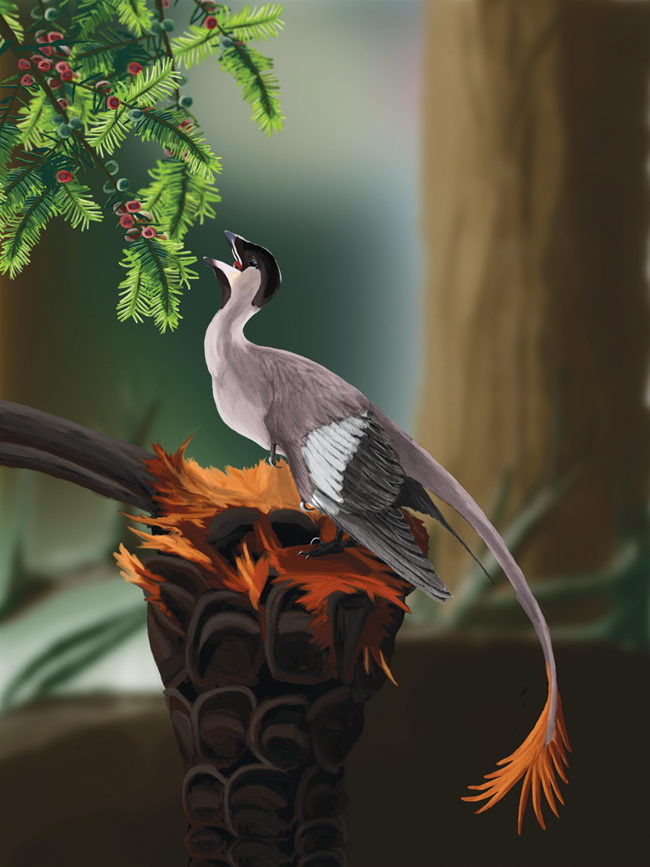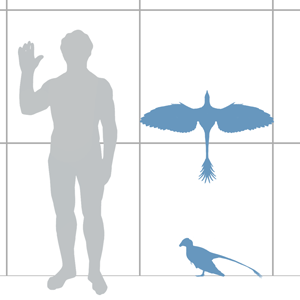home > natural history
Jeholornis prima
"primitive Jehol bird"

Jeholornis was a fairly primitive bird for its time, a relic in its own environment. It lived alongside a wide array of more advanced ribbon-tailed Opposite Birds (enantiornithines) and even the modern-looking true fan-tailed birds (ornithuromorphs). Jeholornis, though, retained the primitive skeleton, long, bony frond-tipped tail, and even a "sickle claw" on the foot remeniscant of its cousins the dromaeosaurids. Still, it possessed some advanced features, like its nearly toothless jaws (it had several tiny teeth in the lower one) and very long arms, longer than the legs. Its shoulder girdle was strong compared to more primitive birds but still strong enough for only clumsy powered flight at best--it lacked the strange parallel flight adaptations birds like Confuciusornis developed independently of modern birds.
Thanks to the preserved contents of the stomach in one specimen, we know thatJeholornis was at least partially a fruit or grain eater, ingesting large amounts of seeds (probably from some coniferous plant). Here, it's depicted perched on top of a tree fern stump to get at the juicy aril-covered seeds of a yew tree (Taxus sp., the fossils of which are also found among the Jehol biota of early Cretaceous age Northwestern China). The colors are speculative, though study of melanosomes may eventually reveal the actual feather color.
One note on the name: Shenzhouraptor sinensis ("Chinese Shenzhou bird") was named within days of its likely synonym, Jeholornis prima ("primitive Jehol bird"). The authors of each name have made the case that theirs is correct. As both were published in the same month, whichever paper can be shown to have been distributed earlier wins out. Zhou and Zhang, in 2007, pointed out that Jeholornis was published on July 25 2002 in the weekly journal Nature. Shenzhouraptor was published in the Geological Bulletin of China, a monthly journal. Absent any further evidence, the weekly journal wins because it comes with a specific date of publication.
However, press releases that accompanied the Shenzhouraptor paper are dated July 23 2002, so Shenzhouraptor should get priority by two days, but the case for this has never been published, only discussed online (see here). While Shenzhouraptor may be the older name, most authors have taken the opinion of Zhou and Zhang as essentially first revisors and used Jeholornis as valid. Unlike the case of Scansoriopteryx, which is usually ignored in favor of Epidendrosarus despite its clear priority, the case for Shenzhouraptor has been built entirely in obscure internet messages and web sites, and so it can't be considered valid at this time.
Image Details:
Media: Digital painting, Adobe Photoshop CS3
using WACOM Graphire 3
License:
ALL RIGHTS RESERVED
DESCRIPTION
Length: 80cm (2.6ft)
Weight: 1kg (2lbs)
Location: Jiufotang Formation, Hebei, China
Time: Aptian age, Early Cretaceous, (120 Ma)
CLASSIFICATION
Kingdom: Animalia
Phylum: Chordata
Class: Stem-Aves
Order: Jeholornithiformes
Family: Jeholornithidae
Genus:Jeholornis
Species:J. prima
SYSTEMATICS
Sauropsida
Diapsida
Archosauria
Ornithosuchia
Dinosauria
Theropoda
Coelurosauria
Maniraptora
Avialae
